Australian workplace laws can be complex, but understanding them is essential for every business owner. At SmallBizToolbox, we’ve created this guide to help you navigate the key regulations you need to follow.
From employee rights to employer responsibilities, we’ll cover the crucial aspects of workplace compliance in Australia. This knowledge will help you create a fair, safe, and productive work environment for your team.
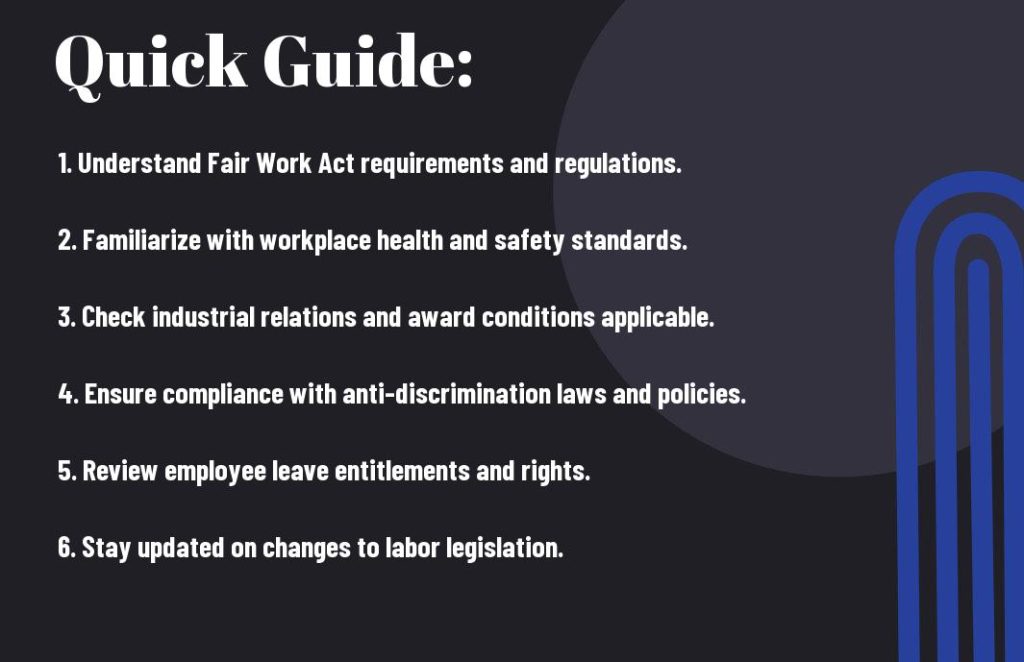
Types of Workplace Laws in Australia
The Australian workplace is governed by various laws that ensure fair and safe working conditions. These laws include:
- Employment standards
- Anti-discrimination laws
- Occupational health and safety regulations
- Workers’ compensation laws
- Industrial relations laws
This combination of regulations serves to protect your rights as an employee and ensure a harmonious work environment.
| Category | Description |
| Employment Standards | Regulations dictating minimum wages, leave entitlements, and working hours. |
| Anti-discrimination Laws | Laws preventing discrimination based on race, gender, age, and more. |
| Occupational Health and Safety | Regulations ensuring a safe workplace free from hazards. |
| Workers’ Compensation | Protection for workers injured on the job, covering medical costs. |
| Industrial Relations | Regulations governing the relationship between employers and employees. |
Key Workplace Laws in Australia
Australian workplace laws form the backbone of fair and safe employment practices. As a small business owner, you need to know four main pieces of legislation that govern how you interact with your employees and handle their information.
The Fair Work Act 2009
The Fair Work Act 2009 is the cornerstone of employment law in Australia. It sets out minimum employment standards, regulates workplace relations, and provides a framework for enterprise bargaining. Under this Act, you must provide your employees with at least 10 minimum entitlements, known as the National Employment Standards (NES). These are the minimum employment entitlements that have to be provided to all employees.
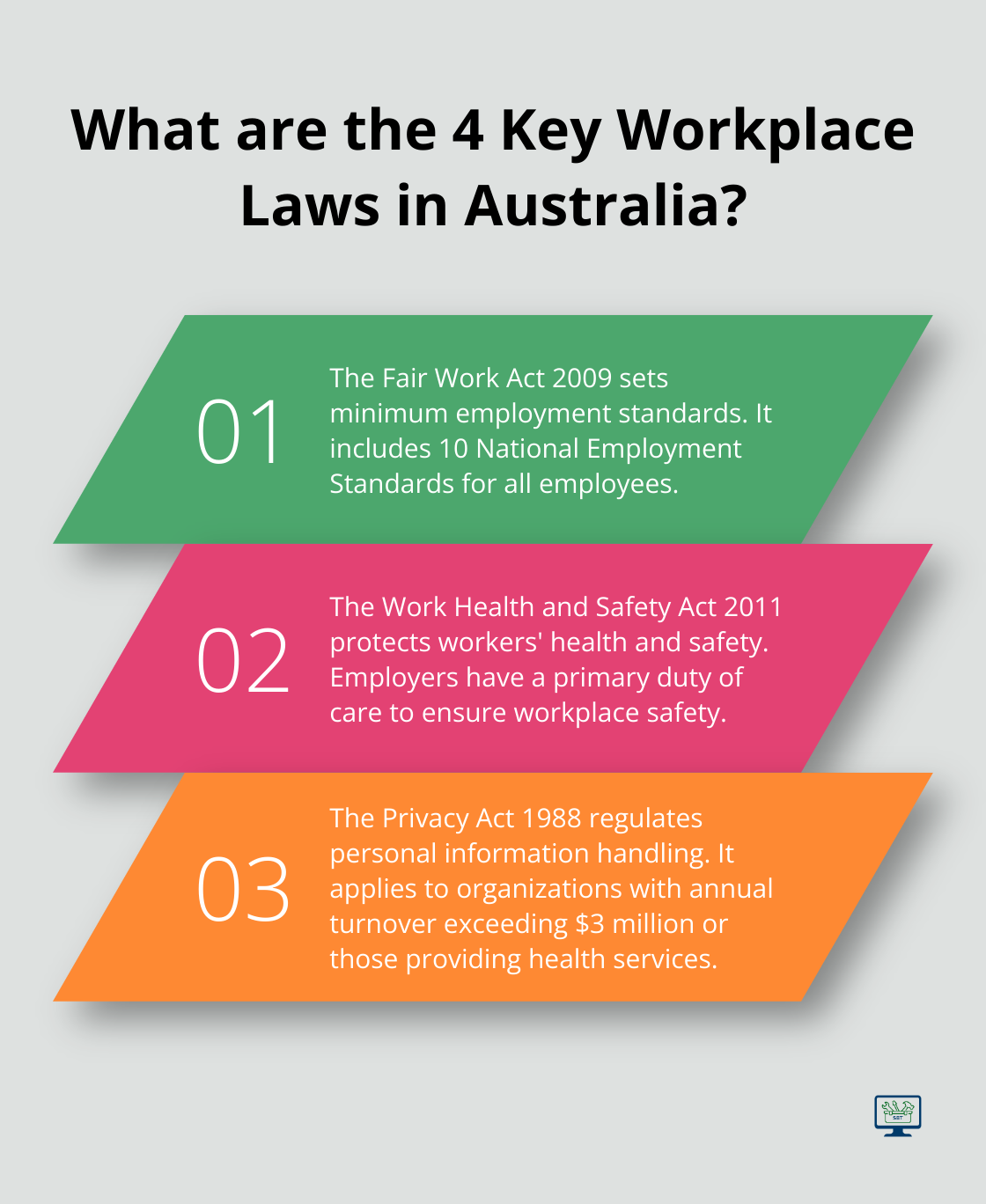
One practical tip: Provide new employees with a Fair Work Information Statement within their first day of work. This document outlines their rights and is available for free from the Fair Work Ombudsman’s website.
Work Health and Safety Act 2011
The Work Health and Safety Act 2011 (WHS Act) protects workers’ health, safety, and welfare. As an employer, you have a primary duty of care to ensure the health and safety of your workers. This includes providing a safe work environment, safe systems of work, and necessary information, training, and supervision.
A practical step: Conduct regular workplace risk assessments. Identify potential hazards, assess their risks, and implement control measures. Document these assessments and review them periodically to ensure ongoing safety.
Privacy Act 1988
The Privacy Act 1988 regulates how organizations collect, use, and disclose personal information. If your annual turnover exceeds $3 million (or you provide health services), you must comply with the Australian Privacy Principles (APPs) outlined in this Act. There are 13 APPs that govern standards, rights and obligations around the collection, use and disclosure of personal information.
Even if you’re exempt, handle employee information with care. Implement a clear privacy policy, secure your data storage systems, and only collect information that’s necessary for your business operations.
Anti-Discrimination Laws
Australia has several federal anti-discrimination laws, including the Age Discrimination Act 2004, Disability Discrimination Act 1992, Racial Discrimination Act 1975, and Sex Discrimination Act 1984. These laws prohibit discrimination against employees based on protected attributes such as age, disability, race, sex, sexual orientation, and more.
To ensure compliance, review your hiring practices, workplace policies, and decision-making processes. Provide regular training to your staff on diversity and inclusion. This not only helps you avoid legal issues but also fosters a more inclusive and productive work environment.
Understanding and implementing these laws can seem overwhelming, but it’s essential for the success and legality of your business operations. Stay informed about any changes to these laws and seek professional advice if you’re unsure about your obligations.
Now that we’ve covered the key workplace laws, let’s explore the specific rights and entitlements that these laws guarantee for employees in Australia.
Employee Rights and Entitlements in Australia
Australian employment law provides strong protections for workers. Small business owners must understand these rights to ensure compliance and create a fair workplace.
Minimum Wage and Modern Awards
The national minimum wage in Australia is $24.10 per hour or $915.90 per week as of July 1, 2024. Many employees fall under modern awards, which set industry-specific minimum wages and conditions. These awards can be complex, so it’s advisable to use the Fair Work Ombudsman’s Pay Calculator to determine the correct rates for your employees.
Leave Entitlements
Full-time employees in Australia receive 4 weeks of paid annual leave per year. Part-time employees get a pro-rata amount. Additionally, employees are entitled to 10 days of paid personal/carer’s leave annually, which they can use for sick leave or to care for immediate family members.
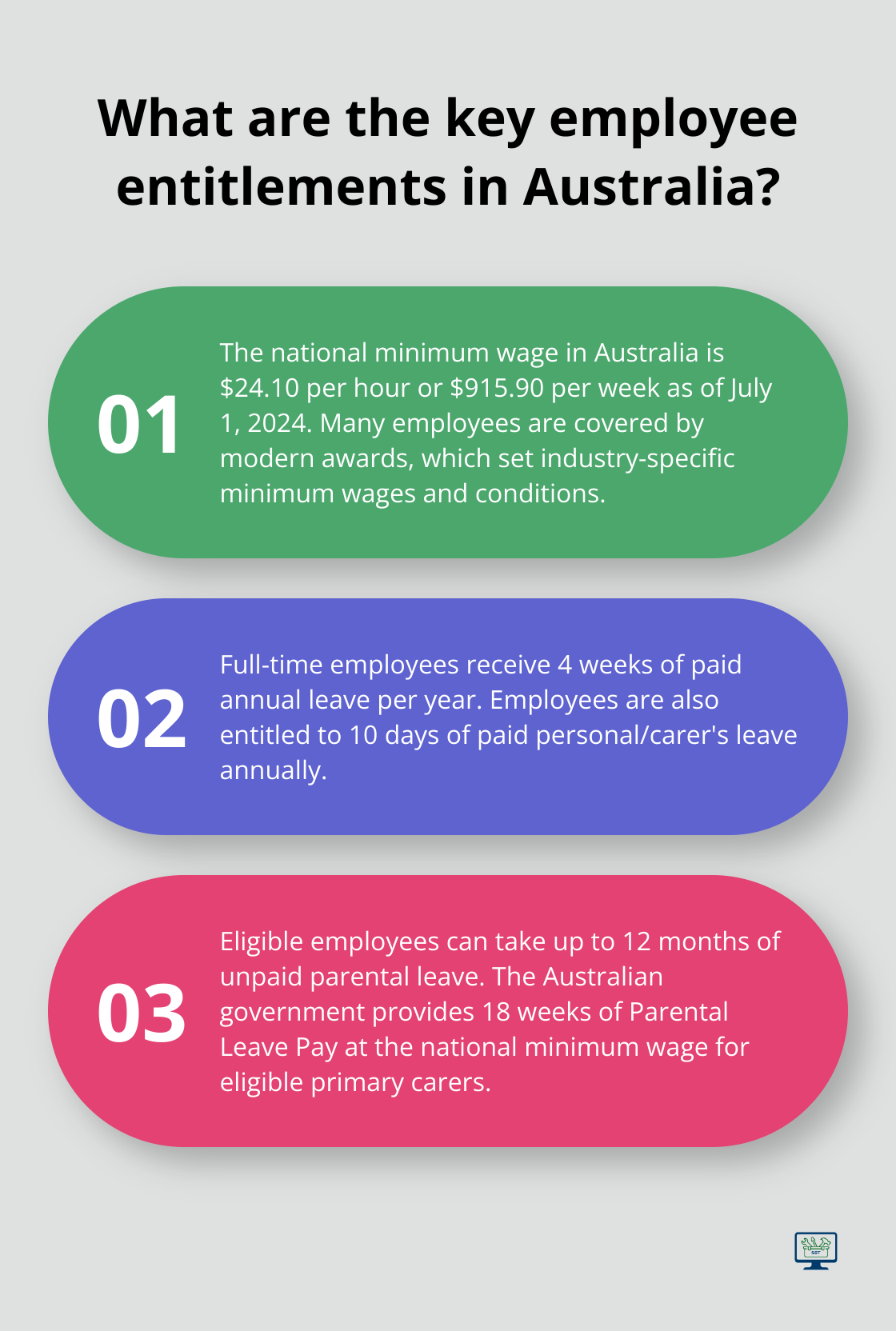
Parental leave is another significant entitlement. Eligible employees can take up to 12 months of unpaid parental leave, with the option to request an additional 12 months. The Australian government also provides 18 weeks of Parental Leave Pay at the national minimum wage for eligible primary carers.
Unfair Dismissal Protection
Employees who have completed a minimum employment period (usually 6 months, or 12 months for small businesses with fewer than 15 employees) receive protection from unfair dismissal. This means you can’t terminate their employment without a valid reason and a fair process. Valid reasons include poor performance, serious misconduct, or genuine redundancy.
To safeguard your business, you should maintain clear performance expectations, document any issues, and follow a proper warning process before considering termination. The Fair Work Commission provides detailed guidelines on this process.
Superannuation Guarantee
As an employer, you must pay superannuation contributions for most employees. The Superannuation Guarantee is an important obligation for employers. It’s essential to stay on top of your superannuation obligations. The Australian Taxation Office imposes penalties for late or missed payments, including the Superannuation Guarantee Charge.
Understanding these rights and entitlements is key to maintaining a compliant and harmonious workplace. Respecting these rights not only keeps you on the right side of the law but also creates an environment where employees feel valued and protected. This can lead to increased productivity and loyalty.
Now that we’ve covered employee rights and entitlements, let’s explore the specific responsibilities that employers have in Australia to ensure a safe and fair workplace.
What Are Your Key Responsibilities as an Employer?
Create a Safe Work Environment
As an employer in Australia, you have a primary duty of care for your staff and are responsible for work health and safety in the workplace. This obligation extends beyond mere compliance with the Work Health and Safety Act 2011. You should actively identify and mitigate risks. Start by conducting regular safety audits. Safe Work Australia offers free resources and checklists for various industries. Use these to identify potential hazards in your workplace.
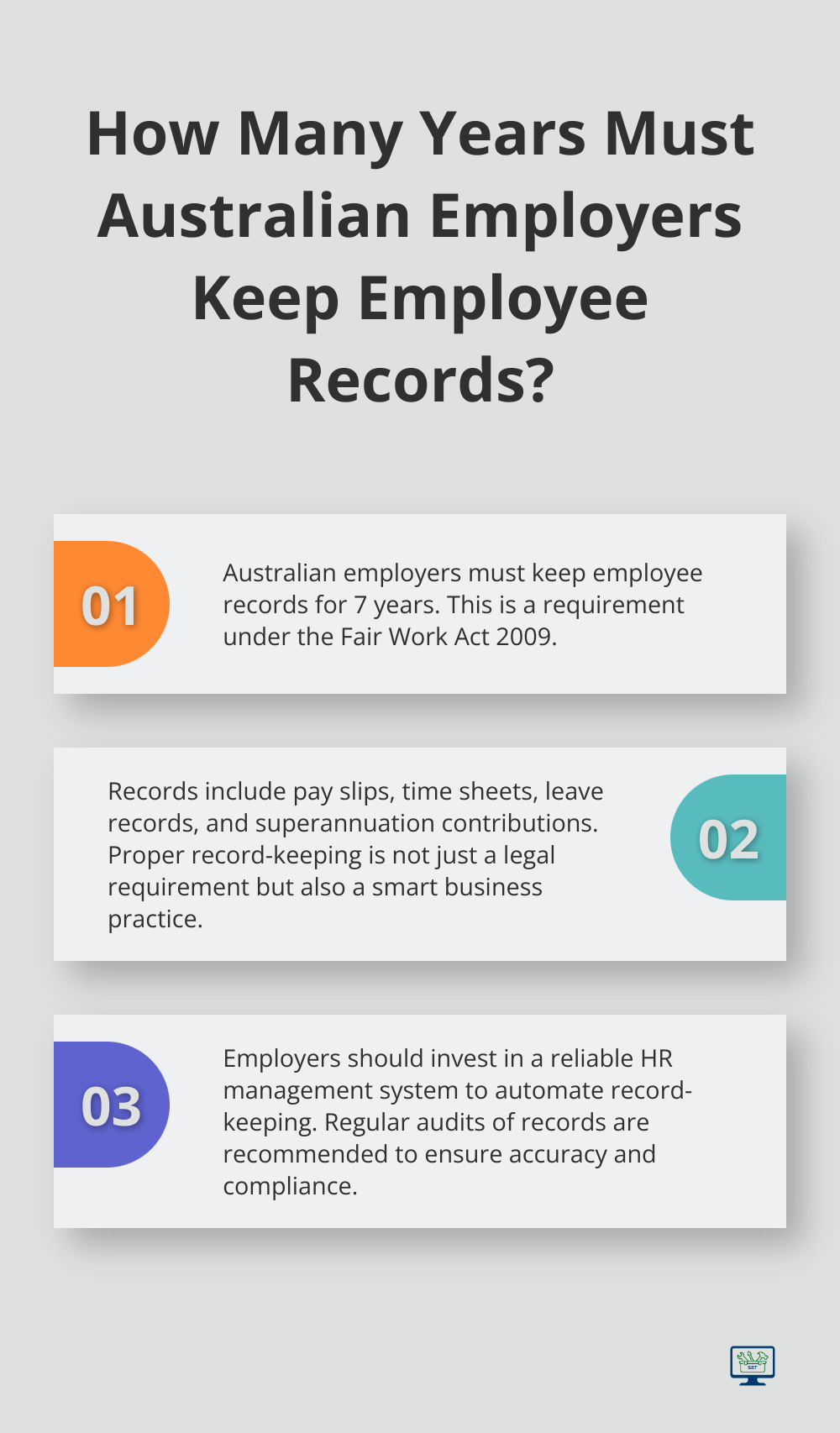
After identifying risks, take immediate action. This might involve updating equipment, providing personal protective gear, or changing work processes. Document all these steps in a safety management plan. Review and update this plan at least annually.
Training plays a vital role in workplace safety. Provide comprehensive safety training to all new employees and regular refresher courses for existing staff. Keep detailed records of all training sessions. This approach not only helps prevent accidents but also protects you legally if an incident occurs.
Maintain Accurate Employee Records
Proper record-keeping is not just a legal requirement; it’s a smart business practice. The Fair Work Act 2009 requires you to keep records for seven years. These include pay slips, time sheets, leave records, and superannuation contributions.
Invest in a reliable HR management system. Many affordable options exist for small businesses. These systems can automate much of your record-keeping, reducing errors and saving time. Regularly audit your records to ensure they’re up-to-date and accurate.
Pay particular attention to time and wage records. Wage underpayment is a serious issue in Australia, often resulting from poor record-keeping. Try to use online resources (such as those provided by the Fair Work Ombudsman) to ensure you’re compliant.
Navigate Termination Procedures
Terminating an employee is never easy, but following proper procedures is essential to avoid unfair dismissal claims. Always have a valid reason for termination, such as poor performance or misconduct. Document all issues leading up to the termination decision.
Before terminating, follow a fair process. This typically involves:
- Give the employee warnings about their performance or conduct
- Provide opportunities for improvement
- Offer support or training if needed
- Allow the employee to respond to concerns
When you terminate, provide the correct notice period or payment in lieu of notice. This varies based on the employee’s length of service and age. Consult the Fair Work website for specific requirements.
Small businesses with fewer than 15 employees have some different rules under the Small Business Fair Dismissal Code. Familiarize yourself with this code to ensure you’re following the right procedures.
Promote Workplace Equality and Diversity
Creating an inclusive workplace is not just a legal requirement; it benefits your business. Start by developing a clear anti-discrimination policy. This should outline unacceptable behaviors and the consequences for breaching the policy.
Implement diversity training for all employees, especially those involved in hiring and management. This training should cover unconscious bias, cultural sensitivity, and the benefits of a diverse workforce.
Review your hiring practices. Do your job ads use inclusive language? Are you reaching a diverse pool of candidates? Consider using blind recruitment techniques to reduce bias in the initial screening process.
Regularly assess your workplace for potential barriers to equality. This might include physical accessibility issues, inflexible work arrangements, or lack of diversity in leadership positions. Address these issues proactively.
Final Thoughts
Australian workplace laws form the foundation of a fair and productive work environment. Compliance with these regulations protects your business legally and fosters a positive workplace culture. This approach leads to increased productivity, employee satisfaction, and ultimately, business success.
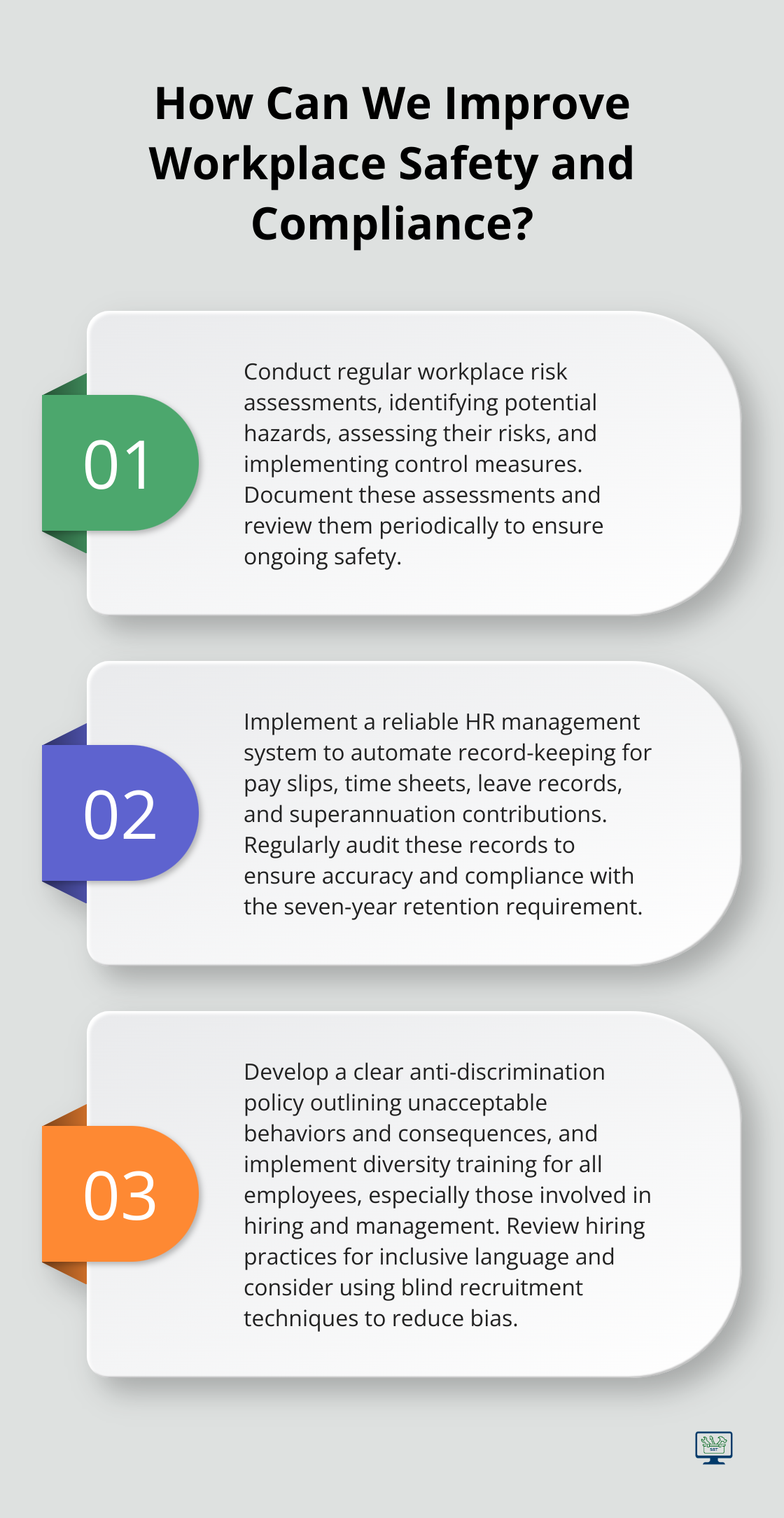
The benefits of adhering to workplace regulations extend beyond legal compliance. Improved employee retention, enhanced reputation, and reduced risk of costly disputes are all positive outcomes. When employees feel valued and protected, they become more engaged and committed to their work.
SmallBizToolbox offers a comprehensive suite of tools and resources to help small businesses thrive in the Australian market. From AI-driven content creation to SEO optimization, SmallBizToolbox provides support to navigate the complexities of running a business (including staying compliant with workplace laws). We encourage you to explore our offerings and take your business to new heights.
FAQ
Q: What are the main workplace laws in Australia that employers need to comply with?
A: In Australia, the primary workplace laws include the Fair Work Act 2009, which governs employment conditions, rights, and obligations. This law sets out the National Employment Standards (NES) that provide minimum rights for employees, such as leave entitlements, maximum weekly hours, and notice of termination. Additionally, there are anti-discrimination laws at both the federal level, like the Australian Human Rights Commission Act 1986, and state and territory levels that prohibit discrimination in the workplace. Employers must also comply with occupational health and safety regulations to ensure a safe work environment.
Q: How does the Fair Work Act 2009 affect employee rights in Australia?
A: The Fair Work Act 2009 establishes key employee rights, including the right to a minimum wage, fair working hours, and entitlements to various types of leave such as annual leave, personal/carer’s leave, and parental leave. It also provides protections against unfair dismissal, ensuring that employees cannot be terminated without reasonable cause and proper procedures. The act also prohibits workplace bullying and harassment, promoting a respectful and equitable workplace. Employers are required to uphold these rights and maintain compliance with industrial relations obligations.
Q: What should employers know about workplace health and safety regulations in Australia?
A: Employers in Australia are required to adhere to the Work Health and Safety Act 2011, which mandates that they ensure the health and safety of their employees while at work. This includes identifying risks, providing necessary training, implementing safety measures, and maintaining a safe work environment. Employers must also consult with employees regarding health and safety matters and keep records of incidents and training. Failing to comply with these regulations can result in legal consequences, including fines and penalties, making it necessary for employers to prioritize workplace health and safety.
How useful was this Resource?
Click on a star to rate it!
Average rating 0 / 5. Vote count: 0
No votes so far! Be the first to rate this post.
We are sorry that this post was not useful for you!
Let us improve this Resource!
Tell us how we can improve this Resource?















